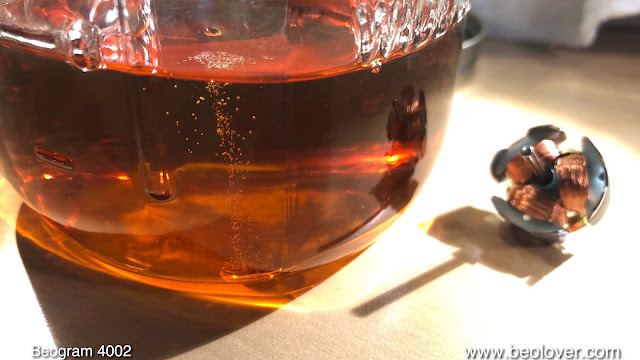A Beogram 4004 motor arrived from Quebec for restoration. It ran a bit noisy, so the diagnosis was 'needs Oilite bearings re-infused with oil'. This shows the motor as received:
I took it apart to extract the bearings:
The bearings are the two small donuts on the black pad upfront. I started using a new 3D printed tool (grey plastic on the right that holds the bottom part of the motor housing) that allows me pressing out the plastic-type brush carriers of 1977 and later motor generations in their entirety. This reduces the risk of breaking the pickup coil leads or damaging the plastic carrier when extracting the bottom bearing.
I immersed the bearings in motor oil and pulled a vacuum. Immediately, vigorous bubbling occurred:
The bubbling indicates that the vacuum pulls out the air from the dry bearing pores. This makes room for oil to diffuse into the bearing, which then can lubricate the shaft of the rotor again.
After about three days the bubbling stopped and I extracted the bearings from the oil:
I re-assembled the motor and installed it in one of my Beogram 4002s for a 24 hrs RPM stability measurement with the
BeoloverRPM device. It allows logging the RPM in 10s intervals over extended periods of time.
The blue curve in the graph below is the curve I measured:
Obviously, something was not right yet. Usually, if the oil infusion does not stop RPM drops entirely, one or more of the spark snubbers of the motor are gone. So I took the motor apart once more and installed unidirectional TVS diodes to replace the original spark snubbers. This shows the rotor with the original 'ring' of snubbers installed:
I unsoldered the connections of the devices:
One of the snubber devices was packed one with some glue. I had to gently heat up the area with my hot air blower to get the device off without destroying the rotor windings. Then I installed new unidirectional TVS diodes:
And tested the motor again. This yielded the green curve in the above graph. The drops were gone, as expected, but there were some new spikes to higher RPM.
It turned out that the fix for this issue was to clean the brushes of the motor with a fiberglass brush. Upon closer inspection the brushes showed an unusual build up of carbonaceous residue in the area where they make contact to the commutator of the motor. My theory is that the motor was run for extended periods without proper spark suppression.
I put the motor back together again and measured another RPM stability curve (shown in red in the above graph). This curve is pretty much as good as it gets. In my experience the small variations that are still present will go away after playing the deck for a while (it seems the bearings and the shaft need some time to find perfect alignment after reassembling these motors). This motor is ready for duty again!



















